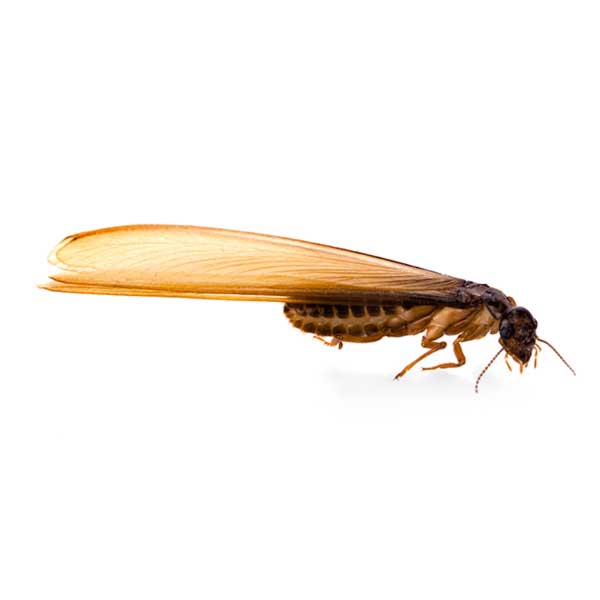Eastern Subterranean Termites in North Carolina
The eastern subterranean termite is a social insect and the most common and widely distributed termite in North America. Due to its wide distribution, it is considered the most economically important and damaging species in the U.S. Termites consume cellulose, the main structural component of plant cells. Any wood material in a home is a potential food source, but it may also damage non-wood material in search of food. Termites rarely show themselves in the open, and infestations can be difficult to detect until the damage becomes severe.
Signs of an Eastern Subterranean Termite Infestation
Recognizing the signs of a termite infestation early can prevent damage to your property. Key signs include:
- Mud Tubes: Thin tubes along foundation walls, beams, and other structures, which termites use to protect themselves from predators and maintain moisture.
- Swarmers: The presence of swarming termites or their wings alone is a sure sign that termites are working in a building. Winged termites are often confused with winged ants; however, most species of ants in the house are only nuisances and, except for carpenter ants, they do not damage the wood.
- Damaged Wood: Termites eat wood from the inside out, leaving it hollow and sometimes with a blistered appearance. Tap on wooden surfaces to check for hollow sounds.
- Frass: This sawdust-like material is termite droppings and is often found near damaged wood.
Habitat, Diet, Life Cycle & Behaviors
Where Do Eastern Subterranean Termites Live?
Eastern subterranean termites live in the ground and feed on plant materials. In structures, they live in walls, basements, crawl spaces, and other damp areas. They build intricate tunnel systems and mud tubes to travel between their nest and food sources, primarily wood. The termites are typically found in soil, where they create nests and forage for cellulose-based materials. They require a moist environment to survive, often infesting damp, decayed wood near the soil.
Diet
Eastern subterranean termites primarily feed on cellulose from wood and other plant materials, especially damp or decayed wood. However, they can also damage dry, sound wood.
Life Cycle
After swarming and mating, the queen lays the eggs that establish a new colony, hatching into nymphs. On reaching adulthood, they form part of the colony’s caste system as workers, soldiers, or the reproductive winged alates. Only the alates (also known as swarmers) mate and establish new colonies.
Behaviors
Termites swarm in the spring to find a mate. Winged termites are attracted to light and will swarm around doors and windows. After fluttering about for a short time, the termites break off their wings and pair off, becoming king and queen of a new termite colony. A common sign of termites is the presence of mud tubes, inside or outside of a home. Termites make these earth-colored tubes primarily as a protected runway from the earth to the wood they feed upon.
Are Eastern Subterranean Termites Dangerous?
While eastern subterranean termites are not directly dangerous to humans, they do pose a significant threat to your property. Because termites consume cellulose, any wood material in a house is a potential food source. Termites are secretive, and when termite damage becomes evident, it is usually the result of a few years of infestation.
How to Get Rid of Eastern Subterranean Termites?
Eliminating an eastern subterranean termite infestation requires a comprehensive approach, combining both chemical treatments and non-chemical methods to help prevent future infestations.
The first step in termite control is a thorough inspection by a professional pest control company. This assessment identifies the extent of the infestation and potential entry points. It includes checking for mud tubes, damaged wood, and moisture issues that may attract termites.
Termite treatments include:
Baiting Systems: Termite bait stations are strategically placed around the property. The bait contains a slow-acting chemical that termites carry back to the colony, effectively eliminating it over time.
Liquid treatment: This treatment is applied to the soil around a structure to create a barrier that termites cannot cross.
In addition to chemical treatments, several non-chemical methods can help control and deter termite populations, including physical barriers to prevent entry; moisture control through proper drainage, leak repairs, and ventilation; and wood treatments to prevent termites from feeding on the treated structure.
Always contact your local termite exterminators for help with eastern subterranean termite problems.
Need help with Eastern Subterranean Termite control?
Need Pest Control Service?
Leave your information below and we’ll be in touch with a FREE quote!
"*" indicates required fields
*During normal business hours. After hours calls will be returned the next business day.
FAQs
Should I Worry About Subterranean Termites?
Yes, subterranean termites pose a significant threat to property due to their ability to consume wood and other cellulose materials. This can compromise the structural integrity of buildings, leading to costly repairs and potential safety hazards. Early identification and control are essential.
Do Eastern Subterranean Termites Only Eat Framing Lumber?
No, eastern subterranean termites do not limit their diet to framing lumber. They feed on cellulose found in wood and other plant materials. They can damage any wood in your home, including flooring, furniture, and other structural components, especially if the wood is damp or decayed.

